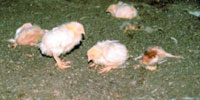Symptoms and Diagnosis
 |
| Posture of sick birds. |
Outward signs of coccidiosis in chickens include droopiness and listlessness, loss of appetite, loss of yellow color in shanks, pale combs and wattles, ruffled, unthrifty feathers, huddling or acting chilled, blood or mucus in the feces, diarrhea, dehydration, and even death. Other signs include poor feed digestion, poor weight gain, and poor feed efficiency. Some symptoms can be confused with other diseases. For example, necrotic enteritis is a gut disease that also causes bloody diarrhea.
Producers in the past identified coccidiosis outbreaks as either severe-acute or chronic, which was less severe but more widespread.
If concerned about coccidiosis, do a necropsy – put on plastic gloves and cut open the chicken. Look at the intestines and then cut them open. If done soon after death, it may be possible to identify characteristic lesions or sores in the gut. Coccidiosis causes a thickening of the intestines, which make them feel like a sausage. There may be light-colored spots on the surface of the gut, and inside the gut, hemorrhages and streaks. If you want to confirm a diagnosis, you can send scrapings of the gut lining to a state diagnostic lab. The USDA’s Animal and Plant Health Inspection Service’s Web site lists diagnostic labs.
 |
| Small intestines affected by Eimeria maxima. The middle sample is opened to show white spots. |
|
 |
| Note the ballooning. |
|
The type and location of lesions in the gut indicates the species of Eimeria.
- Eimeria acervulina affects the upper part of the small intestine. You may see small red spots and white bands on it.
- Eimeria maxima affects the entire small intestine. The intestines look watery, and in later stages have blood and mucus. The intestine may look thickened and ballooned with red pinpoint lesions.
- Eimeria tenella affects the blind sacs (ceca) of the gut. They may be filled with blood and pus and turn into a solid core.






 © 2000 - 2021. Global Ag MediaNinguna parte de este sitio puede ser reproducida sin previa autorización.
© 2000 - 2021. Global Ag MediaNinguna parte de este sitio puede ser reproducida sin previa autorización.